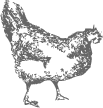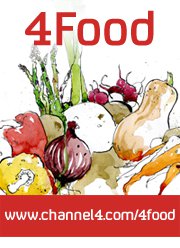
Sam has challenged all of us English to stick up for our much-maligned national cuisine, which is a fine idea but leaves us all with a bit of quandary; do we showcase one of our traditional dishes or do we attempt to show “how much we have come on”?
One of the things I think we Brits/English do really well is this local eating and reducing food miles business. One of the advantages of living on such a small island is that when we try to eat local it really can mean local. Not for us a 100-mile radius like those Bay Area people I keep hearing about – no disrespect intended if any of you are reading :-) Nope, over here local is often very local indeed (100 miles is after all, a quarter of the length of England). From where I live at the edge of a reasonably large city (Oxford) I can get artisan cheeses, an impressive choice of organic veg, melt-in-the-mouth sustainably farmed lamb all within the 18 miles from my house.
An area of British produce that has seen a big surge in popularity in recent years with both health-conscious and ethically-concerned shoppers is venison. The main species of deer farmed for venison in England is the red deer, indigenous to Britain, which I think fits nicely with the theme of the event. I far prefer the idea of eating an animal that has been reared out and about in something close to its natural habitat (hence my thing about lamb recipes) and the increase in sales suggest that there are a lot of other peope who feel the same way. Deer for the most part are still reared on expansive parkland in England, though I understand that the same is not true of all countries.
Red meat has a bad reputation nutritionally-speaking. Some, but not all of these concerns are related to the saturated fat content of the meat, so if you do eat red meat occasionally then naturally low-in-fat venison is an excellent choice. It is much lower in fat (including saturated fat) than other red meats, while retaining the typical beneficial attributes such as high quality protein and easily-absorbed iron. The venison in my casserole contains 165 kcal in it per 100g, and 2.5g of fat, whereas my next choice, lean (trimmed) braising steak that would have contained 225 kcal and 9.7g of fat.
On to the second big ingredient in this casserole. Making damson or sloe gin is just about as English as you can get (in a very rural way). You can read more about this tradition at the wonderfully named sloe.biz, but it essentially involves soaking fruit in gin and sugar for a few months, creating a beautifully pink and very potent tipple. Timing means that the gin is usually ready to try just in time for Christmas, Hurrah!
I’m too lazy to collect sloes, which involves spotting the hedgerow flowers in the spring and remembering their exact position ready to go back and pick the berries in the Autumn. As well as remembering where you saw them, you have to be a master of timing – too soon and they won’t be ripe (after the first frost is best) but too late and you’ll lose out (there can be fierce competition for a good crop of sloes!). But I’m saved from all this competitiveness by the lovely damson tree in my own back garden which I can keep an eye on from my kitchen window.
Anyway, after all the waiting (this year I have left mine to steep for an especially long time, way past Christmas), you are left with not only the drink itself but also a big batch of booze-sodden fruit. My Yorkshire roots pretty much prohibit me from throwing the fruit away, hence the birth of this casserole. This is all very well, I hear you thinking, but what about all those of you who don’t happen to have a batch of boozy damsons to hand right this minute? I’ve got two ideas for you. First, if you want to get into the spirit of things (literally), you could try making some plum gin rather than the damson or sloe variety (google and you’ll find a few people have tried this and it seems to work). Second choice, much easier, is to substitute the damsons for something fruity and sweet straight from the larder; a few stoned plums or cherries, or dried prunes soaked in cranberry juice overnight.
Anyway, back to my initial musing on what sort of dish to make. This venison casserole is I hope somewhere in between traditional and modern, with a nod to very English traditions and produce, but still a long way from our old reputation for high-fat, low-flavour stodge. We had our casserole with straightforward mashed potato and veg, sticking with the theme, but I have a sneaking suspicion that it would be even better with sweet potato mash. Follow the meal with a snifter of your own damson gin or a fine shop-bought specimen of sloe gin which I’m sure would go down equally well.
Recipe for Boozy Damson and Venison Casserole
Serves 4
See above for suggestions for what to put in instead if you don't have any boozy damsons.
800g Venison Steak, cut into large chunks
1 large onion, cut in half then sliced
2 sticks celery, finely sliced
2 cloves garlic, finely chopped
20 or so boozy damsons (cut in half and stoned)
1 tbsp olive oil
1 bay leaf
1 tbsp fresh rosemary, chopped
15 or so dried juniper berries, crushed with a pestle and mortar
1 big piece of orange peel
Hot water
Salt and pepper
Find a large pan with lid and that is suitable to use on the hob.
Heat the olive oil and quickly fry the venison chunks in two batches so as not to overcrowd the pan, cooking just long enough to brown and seal the outside of the meat. Remove the meat from the pan and put it to one side, seasoning with salt and pepper.
Cook the celery, garlic and onions in the olive oil and meat juices left in the pan on a low heat for about 10 minutes, taking care not to brown them.
Return the venison to the pan that contains the vegetables (include any juices that have seeped out of the meat) and add all of the remaining ingredients (click here for a picture of what it looks like at this stage). Pour in enough hot water to just cover the ingredients.
Place a lid over the stew and let it only just simmer for about 2 and a half hours. I left mine on the hob but you could probably put in in the oven on a very low heat. Like all stews it will look vile for the first hour and forty-five minutes or so but will miraculously thicken-up and turn into something wonderful all of a sudden.

 Come join me on Twitter
Come join me on Twitter Sophie Roberts is a registered dietitian based in Oxford, UK. She loves combining her nutrition know-how with a sustainable approach to buying and preparing food and shares her tips and recipes here at Mostly Eating.
Sophie Roberts is a registered dietitian based in Oxford, UK. She loves combining her nutrition know-how with a sustainable approach to buying and preparing food and shares her tips and recipes here at Mostly Eating. 
{ 8 comments }
I love sloe gin – I knew someone who used to make it and I loved it. Sadly he died some years ago. I never tried the damson version, though, it sounds great to me. Thanks for sharing your eating local views too, it always makes me laught that 100 miles seems so large compared to what might be considered local in the UK – I guess everything is just so much more spread out here.
thanks for joining in Fish & Quips
sam
dito on the “local eating” here in Germany (although its’s larger than Britain).
I nearly drowned laughing when I read about the definition of “local” in the US in TIME while lying in the bathtub. Especially the comment that California was the only place in the world where good all-local cuisine was possible seemed arrogant and ignorant to me.(Again: no offense intended and I’m quoting from my memory, so if I got a fact wrong, sorry)
I made sloe gin for the first time last year and I still have a large bag of those dry berries frozen. I love the look of the damsons with the venison! Delicious!
Hi Sam – thanks for organising, you’ve done an amazing job going round all 65 entries (I hope we showed ’em!)
Mathias – I’m glad it’s not just me thinking 100 miles sounds like a long way :-)
Freya – I thought this would be a bit of a niche recipe but I knew somebody somewhere must have some leftover sloe or damson fruit!
I don’t think I’ve had damsons before but, if they’re boozy, they’ve got to be good.
I love venison. Have you tried venison shanks before? I tried them for the first time this week and they were great marinated and slowcooked. I used a really similar recipe to yours minus the damsons and with added ruby port.
Interesting Blog with a good layout, keep up the good work.
I love to idea of this recipe, but I made damson brandy this year (highly recommended and it only takes three months to be ready) so I don’t have any gin-soaked damsons. I have gin-soaked sloes though: do you think it would work with those?
Hello great website! Does running a blog similar to this require a massive
amount work? I’ve no expertise in programming but I
had been hoping to start my own blog in the near future. Anyway, should you have any
recommendations or tips for new blog owners please
share. I know this is off subject but I just had
to ask. Cheers!